
* Alexander Yakovlev's experimental design bureau (OKB in its Russian acronym) provided the Soviet Union with the excellent "Yak" piston-powered fighters in World War II, and in the postwar period built a set of jet fighters evolved from their piston fighter designs that brief service lives, but allowed Soviet pilots to acquire experience with jet operation. The future of the Yak organization lay primarily with airliners and transports.
However, the organization did make a major contribution to Cold War Red air power, in the form of a series of supersonic twinjet combat aircraft, the "Yak-25" through "Yak-28", that were built in good numbers and served in a wide range of roles -- including interceptor, reconnaissance platform, bomber, and countermeasures platform. This document provides a history and description of these Yak twinjets.
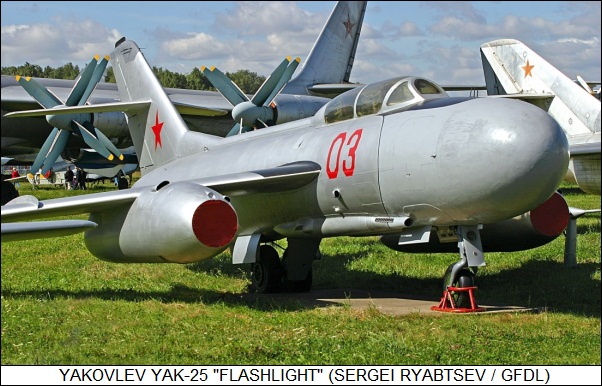
* In the late 1940s, following the Soviet development of a first generation of jet fighters such as the MiG-9 and Yak-15, the USSR began work on an improved second generation of fighters, the most prominent of which would be the Mikoyan MiG-15 of Korean War fame. A parallel effort focused on the development of a twin-engine, two-seat, radar-equipped night / all-weather interceptor, defined by issue of a state requirement in early 1949. The Mikoyan OKB worked on the "I-320 Mark 2" -- the "I-320 Mark 1" was a more or less unrelated aircraft that never got out of the paper stage -- while the Lavochkin OKB worked on the "La-200".
There were some similarities between the two machines, both being low-wing aircraft with all-swept flight surfaces and tricycle landing gear, powered by twin Klimov RD-45 / VK-1 centrifugal flow turbojets (Soviet copies of the British Rolls-Royce Nene engine) arranged in tandem in the fuselage, with side-by-side canopies for pilot and radar operator, and Toriy (Thorium) radar -- later updated to improved Korshun (Kite Hawk) radar. The intake was in the nose, with the I-320 Mark 2 featuring the radome in the upper intake lip; the first La-200 prototype featured the radome in the center of the intake, but the second moved it to the upper lip.
Their specifications were similar, not surprisingly since they both had the same engines and similar kit. The I-320 Mark 2 had a span of 14.2 meters (46 feet 7 inches), a length of 15.77 meters (51 feet 9 inches), and a normal loaded weight of 10,725 kilograms (23,645 pounds). The La-200 had a span of 12.92 meters (42 feet 5 inches), a length of 16.59 meters (54 feet 5 inches), and a normal loaded weight of 10,375 kilograms (22,875 pounds). Both had high subsonic performance and a range of about 1,200 kilometers (750 miles).
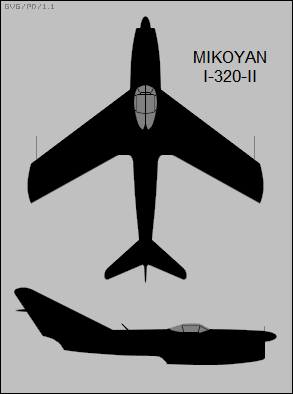
Both machines were also almost unarguably ugly: the Soviets were functionalists and not picky about appearances, but these machines were pushing the limit. The two aircraft went through state trials in 1950:1951, only to be rejected, apparently because of problems with the Toriy / Korshun radar and because the range specification had been raised considerably.
The engineers in the Yakovlev OKB felt they could meet the revised requirement using the new Mikulin AM-5 axial-flow turbojet and long-range RP-6 Sokol (Falcon) radar then in the works. They proposed a new design for a twin-engine, two-seat, long-range, night / all-weather interceptor; the authorities liked the proposal, and in August 1951 authorized development of the type, to be given the OKB designation of "Yak-120". A tactical photo-reconnaissance variant, with the OKB designation of "Yak-125", was to be developed as well. A variant of the La-200 with the Sokol radar, the "La-200B", was to be developed as a backup plan.
Initial flight of the first of seven Yak-120 prototypes (six flight prototypes and a static-test airframe) was on 19 June 1952, with OKB test pilot V.M. Volkov at the controls. The Yak-120 was ordered into production as the "Yak-25" in late 1953, recycling the designation of a single-engine Yak jet fighter that never reached production. The twinjet Yak-25 reached operational service with the Soviet national air-defense service, the PVO (Protivo-Vodushnoy Oborony), in 1955.
Due to development delays with the Sokol radar, early Yak-25 production featured the shorter-range RP-1 Izumrud radar; later production with the Sokol radar was designated "Yak-25M", though in practice these machines were simply referred to as Yak-25s. After its unveiling to the West in a flypast at the Tushino airshow in July 1955, the type was given the NATO reporting name of "Flashlight" -- later revised to "Flashlight-A" when new variants were introduced.
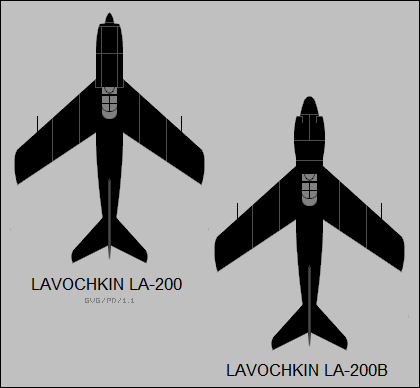
As far as the La-200B was concerned, it was even uglier than the La-200, as if it were possible, with a big radome stuck in the nose, bracketed by three engine intakes. It was clearly inferior to the Yak offering. The La-200B ended up being used as an avionics testbed.
BACK_TO_TOP* The Yak-25M was very different from the I-320 and La-200, with a rounded nose for the big Sokol radar; a tandem-seat canopy; swept flight surfaces; an AM-5A engine in a nacelle mounted under each wing; and bicycle landing gear. Construction was mostly of aircraft aluminum alloy. The wings were mid-mounted, with a sweepback of 45 degrees at quarter-chord, an anhedral droop of 5 degrees, twin spars, ailerons, two-section flaps, and two wing fences on each wing (the prototypes had a single fence on each wing) to prevent loss of airflow down the wing. The swept tail assembly's control surfaces were conventional; there was a ventral fin under the tail. Ailerons and elevators were hydraulically boosted, while the flaps were pneumatically actuated. There was a hydraulically actuated airbrake on each side of the rear fuselage; the airbrakes were automatically deployed by the crew ejection sequence.
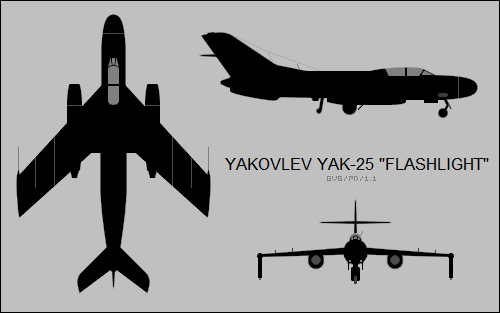
All fuel storage was in the fuselage, using four bladder tanks. Each non-afterburning RD-5A / AM-5A engine provided 19.6 kN (2,000 kgp / 4,850 lbf) thrust. Engine bleed was used for de-icing flight surfaces and engine inlets, though the engine centerbodies and intake foreign-object damage protection screens featured electrical de-icing systems. The bicycle landing gear featured one wheel up front, two wheels in the rear, and a small outrigger on each wingtip that retracted into a fairing. All the landing gear were pneumatically actuated and retracted backwards.
The aircrew sat on ejection seats under a long single-piece canopy that slid back to open. The windscreen featured armored glass, the seat backs and headrests were armored, and there were front and side cockpit armor plates as well. The cockpit was pressurized and climate conditioned. The radar operator's position included flight controls, allowing the back-seater to take over and spell the pilot when needed. Avionics featured standard kit such as identification friend or foe (IFF) unit, radio, intercom, and autopilot; but also relatively sophisticated navigational gear, useful for a long-range / night / all weather aircraft, including an automatic direction finder unit, a marker beacon receiver, a radar altimeter, and instrument landing system.
The RP-6 Sokol radar was the centerpiece of the avionics suite. The Sokol had a range of 30 kilometers (18 miles) and good low-altitude capability. Russian sources claim it had a "look down" capability, able to see through ground-return "clutter", but that would be an impressive capability for a radar of that era. It seems more likely that it had a narrow beam that allowed the radar to operate relatively close to the ground without picking up a clutter return -- with this impression enhanced by the fact that the radar would prove in service easily jammed by chaff or active radio jammers, implying little ability to screen out clutter. The radar operator viewed the radar display through a hood.
Armament consisted of twin Nudelman N-37L 37-millimeter automatic cannon, with a normal ammunition load of 50 rounds per gun. A conformal external fuel tank could be carried on the centerline.
___________________________________________________________________
YAKOVLEV YAK-25 "FLASHLIGHT-A":
___________________________________________________________________
wingspan:
11 meters (36 feet)
wing area:
28.94 sq_meters (311.2 sq_feet)
length:
15.7 meters (51 feet 4 inches)
height:
3.8 meters (12 feet 6 inches)
empty weight:
5,675 kilograms (12,500 pounds)
take-off weight:
10,045 kilograms (22,145 pounds)
maximum speed:
1,015 KPH (630 MPH / 550 KT)
service ceiling:
15,000 meters (49,200 feet)
range, no tanks:
2,100 kilometers (1,305 MI / 1,135 NMI)
___________________________________________________________________
480 Yak-25s were built into 1957, including the prototypes. In service, many Yak-25s were later fitted with the Gorizont-1 (Horizon-1) ground-controlled intercept (GCI) datalink system, with these machines sometimes given the designation of "Yak-25MG".
The Yak-25 normally flew in natural metal colors. It was well outnumbered in PVO service by the Mikoyan MiG-17P single-seat interceptor, it seems mostly because the MiG-17P was substantially cheaper than the big Yak-25. The Yak-25 was generally regarded as capable, reliable, and pleasant to fly -- agile for such a relatively large aircraft, and with good engine-out handling. The low-slung engines did mean that "foreign object damage (FOD)" was a real problem, even though intake screens were fitted, and runways used for Yak-25 operations had to be kept clean of debris.
Due to its size and good flying characteristics, the Yak-25 was also well-suited to service as a testbed, sometimes under the designation of "Yak-25L" or "Yak-25LL", where "LL" meant "Letayuschchaya Laboratoriya (Flying Laboratory)" -- a general suffix often applied to testbed aircraft. Such conversions included ejection-seat testbeds, de-icing system test platforms, and engine testbeds.
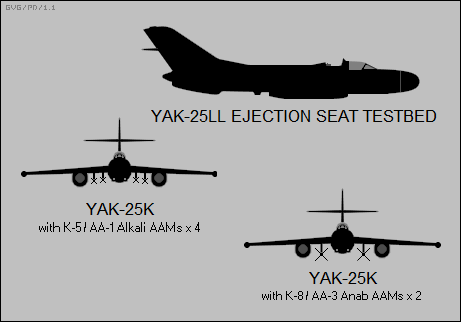
Several Yak-25s were converted to carry four K-5 / RS-1-U beam-riding air-to-air missiles (AAMs), NATO reporting name "AA-1 Alkali", with two missile pylons under each wing, inboard of the engine; these aircraft were fitted with RP-1-U Izumrud radar to guide the AAMs. In principle, these were service machines, designated "Yak-25K", but in practice, they were weapons testbeds. Yak-25Ks were produced by modification to test other AAMs, such as the K-8 (NATO "AA-3 Anab"), but it doesn't seem that any Flashlight ever carried AAMs operationally.
The Yak-25 remained in service with the PVO into the late 1960s. It was never operated by the air arms of any other nation; none of the Yak twinjet combat aircraft were. Combat action of the Flashlight was limited to the occasional intercept of intruders into Soviet airspace. This was a common sort of thing during the Cold War; it is unclear if any Yak-25 ever fired shots in anger. After their firstline service, many Yak-25s were converted into radio-controlled target drones, with the designation of "Yak-25M" or "Yak-25Msh", where "M" stood for "Mischen (Target)". The first conversions were performed in the late 1950s. It is unclear when the last of the Yak-25 targets were expended.
BACK_TO_TOP* Late in the Yak-25's production life, the Yak OKB was tasked with the development of a high altitude, long range strategic reconnaissance aircraft based on the Flashlight, to be designated the "Yak-25RV", where "RV" stood for "Razvedchik Visotniy (Reconnaissance, High Altitude)". Initial flight of the prototype was on 1 March 1959, with test pilot V.P. Smirnov at the controls. Once NATO got wind of the type, it was assigned the reporting name of "Mandrake".
The Yak-25RV was so heavily modified from the basic Yak-25 that it seems plausible the Yak-25 designation was retained partly as a cover. The only thing the Yak-25RV retained from the Yak-25 was the rear fuselage; it featured a new forward fuselage, with a single-seat cockpit and a solid camera nose. Cameras were also fitted into the belly of the aircraft.
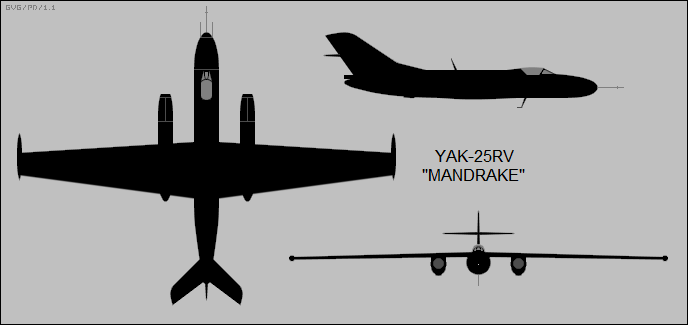
The wings were straight and long, with a span of 23.5 meters (77 feet 1 inch), and no wing fences -- they weren't needed on a straight wing. A Tumanskiy R-11V-300 turbojet was fitted under each wing. The R-11V-300 was a non-afterburning, high altitude version of the R-11 engine used on the Mikoyan MiG-21, and had a maximum thrust of 39.2 kN (4,000 kgp / 8,820 lbf). The tailfin was modified, with a larger forward fin fillet. The wingtip outriggers retracted forward, not backwards as they did on the Flashlight. The Yak-25RV was unarmed.
___________________________________________________________________
YAKOVLEV YAK-25RV "MANDRAKE":
___________________________________________________________________
wingspan:
23.5 meters (77 feet 1 inch)
wing area:
55 sq_meters (591.3 sq_feet)
length:
15.93 meters (52 feet 3 inches)
height:
3.8 meters (12 feet 6 inches)
empty weight:
6,175 kilograms (13,615 pounds)
take-off weight:
9,800 kilograms (21,600 pounds)
maximum speed:
965 KPH (600 MPH / 520 KT)
service ceiling:
21,000 meters (68,900 feet)
range, no tanks:
2,100 kilometers (1,305 miles / 1,135 NMI)
___________________________________________________________________
The VVS (Voyenno Vozdushniye Sily / Red Air Force) found the design adequate, and it was ordered into production in 1961. Details remained mysterious in the West for some time. One set a world altitude record of 20,174 meters (66,187 feet) on 29 July 1964, with V.P. Smirnov at the controls. The aircraft was described simply as the "RV" in the paperwork for the Federation Aeronautique Internationale (FAI), the logging authority for aeronautical records.
74 Yak-25RVs were built, including a small number that lacked reconnaissance gear and were used by Soviet air defenses to practice high-altitude intercepts, in hopes of figuring out how to shoot down high-flying Western intruders like US Lockheed U-2 spyplanes. These Mandrakes were given the designation of "Yak-25RV-1"; they could also be fitted with radio control, to allow them to be used as live-fire targets. A batch of 81 radio-controlled drone targets was also built new, with these machines given the designation of "Yak-25RV-2". All Yak-25RV production was complete by 1965.
The Yak-25RV remained in first-line service with the VVS into the early 1970s. Pictures seem to imply that it normally flew in natural metal colors, though black or very dark blue is arguably a better color for high-altitude operations. It is known to have performed overflights of Pakistan, India, China, and northern Japan. It is not known to have performed any overflights of Western Europe, possibly because air defenses would have been too much for it.

In the late 1960s, a handful of Yak-25RVs were configured for the "radiation reconnaissance" mission, to be redesignated "Yak-25RR", where "RR" unsurprisingly stood for "Radiatsionniy Razvedchik (Radiation Reconnaissance)". They were fitted with underwing pylons to carry two standard radiation sampling pods, which contained paper filters to trap fallout particles from the atmosphere.
In the early 1970s, a few Yak-25RVs were modified as signals intelligence (SIGINT) platforms and designated "Yak-25RRV", where "RRV" stood for "Radioteknichevskiy Razvedchik Vysotny (Radio Signals Reconnaissance, High Altitude)". They were very similar to the Yak-25RR, with two underwing pylons, in this case carrying Volna-S (Wave-S) SIGINT pods.
There was also a scheme floated in the early 1970s to use a version of the Yak-25RV to shoot down balloons. During the 1950s, the US attempted to use high-altitude balloons to perform reconnaissance overflights of the Soviet Union. According to American sources, this was done for a few months in early 1955, using hundreds of balloons, with a single follow-on effort in 1958 with three very large balloons. The two efforts were embarrassing failures -- the second exercise had been performed in violation of a direct order from US President Eisenhower, and he was furious. The US gave it up, but Russian sources insist that reconnaissance balloon overflights continued through the 1970s. Whatever the facts behind this puzzle, the balloon interceptor program was canceled without flight of a prototype.
BACK_TO_TOP* The introduction of the Yak-25 led to a series of efforts to improve the breed and adapt it to other roles, with this work having a tendency to run down blind alleys.
As noted, the initial state authorization for the development of what would become the Yak-25 also envisioned a tactical reconnaissance variant, the Yak-125, and a prototype was duly flown for the first time, by Volkov again, on 26 August 1952. The Yak-125 looked very much like the Yak-25, even retaining the rounded nose, though the nose was made of metal and carried cameras, not radar. The twin N-37L cannon were swapped for a single Nudelman-Richter NR-23 23-millimeter cannon with 80 rounds. The back-seater, in this case a "reconnaissance systems operator (RSO)", had a periscopic sight and a small window in the floor to help target the cameras.
Performance was good enough to persuade the authorities to sponsor further development. The main problem with the Yak-125, as it stood, was that siting the RSO in the rear cockpit was unsatisfactory, not granting him a proper field of view of the terrain. Work was performed to provide a redesigned "glass nose" for the RSO, with ten "Yak-25R" machines built in 1955. However, that was the end of it, since both technology and requirements were evolving rapidly at the time. Interest moved on to something better; the VVS could get by with the Ilyushin Il-28R "Beagle" for reconnaissance in the meantime.
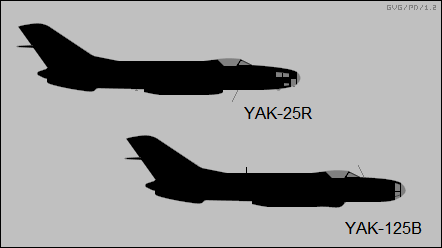
Development of the glass-nosed Yak-25R was paralleled by work on an externally similar tactical nuclear strike aircraft, the "Yak-125B", where "B" stood for "Bombardirovschchik (Bomber)". Along with a reconfigured nose, the main landing gear was modified, with a larger twin-wheel nose gear that retracted forward, and a longer wheelbase. Flight tests of the single prototype were in 1955, with the aircraft fitted with an RMM-2 Rubidy (Rubidium) targeting radar in a small radome in the belly below the cockpit. As with the Yak-25R, more advanced technology was becoming available and there was no interest in pursuing the Yak-125B as it was.
The Red Navy also became interested in using the Yak-25 as the basis for a reconnaissance platform, with the "Yak-25MR" prototype, where "MR" stood for "Morsky Razvedchik (Maritime Reconnaissance)", flying in 1955. This machine retained much the configuration of the Flashlight interceptor, with the tandem-seat configuration and nose radome, but in this case the radome contained maritime surveillance radar, and the machine featured provisions for vertical and oblique cameras. One N-37L cannon was retained. Once again, the Yak-25MR was left behind by improved technology, and the exercise went nowhere.
* One of the driving forces in the search for something better was the availability of new, more powerful engines. A prototype for an improved Flashlight interceptor was flown in 1955, being fitted with afterburning Mikulin AM-9A / RD-9A engines like those used on the Mikoyan MiG-19, providing 26.0 kN (2,650 kgp / 5,840 lbf) max dry thrust and 31.9 kN (3,250 kgp / 7,165 lbf) afterburning thrust. This machine was given the designation of "Yak-120M"; a production machine was to feature improved Sokol-M radar and fuselage-mounted unguided rocket packs to complement cannon armament, with the twin NS-37 cannon replaced by twin Nudelman-Suranov NS-23 23-millimeter cannon.
The Yak-120M was a nonstarter, too, but interest in a Yak-25 derivative powered by RD-9 series engines persisted. In the same year, the Yak OKB flew a prototype of a supersonic-capable tactical nuclear bomber derivative, designated the "Yak-123". It originally featured Mikulin RD-9AK afterburning turbojet engines, with similar thrust ratings to the AM-9As used on the Yak-120M, with the RD-9AK engines later upgraded to more powerful RD-9F engines. It also featured:
Flight test of the initial "Yak-123-1" prototype, without radar and the tail barbette, demonstrated supersonic performance, but handling suffered from some problems. The worst was that at high speeds, the thin wings flexed too much, resulting in "aileron reversal" -- that is, trying to roll the aircraft in one direction perversely resulted in a roll in the other direction.
The design did seem promising and a second prototype, which was optimistically given a "service-oriented" designation of "Yak-26-3", was rolled out in 1956 -- apparently the "Yak-123-2 / Yak-26-2" was a nonflying static-test prototype. The Yak-26-3 featured the uprated RD-9F engines, with 27.0 kN (2,750 kgp / 6,060 lbf) max dry thrust and 37.3 kN (3,800 kgp / 8,380 lbf) afterburning thrust, and included the tail barbette. The features of both prototypes were substantially tweaked during the course of the test program, for example with the nose glazing scheme improved; the tail barbette eliminated since it had proven useless; and in particular improvements to the wings. Construction of a batch of ten preproduction aircraft was authorized.
In the meantime, the Yak OKB was also working on an externally similar reconnaissance variant, the "Yak-122", with a single prototype flown in 1955; and a supersonic interceptor variant, originally designated "Yak-121" but then given the designation of "Yak-27". The Yak-27 was to feature RD-9F engines and two subvariants were to be built, including a cannon-armed "Yak-27P", where "P" stood for "Perekhvatchik (Interceptor)", and a "Yak-27K" with K-8 / AA-3 Anab AAMs; they retained the single-wheel nosegear and shorter wheelbase of the Yak-25. Two initial prototypes of the Yak-27 were flown in 1956, leading to production of a batch of evaluation aircraft. One Yak-27 was flown in 1957 and 1958 with a Dushkin liquid-fuel rocket booster fitted to the tail and designated "Yak-27V"; it had a great rate of climb, but it never went beyond the experimental stage.
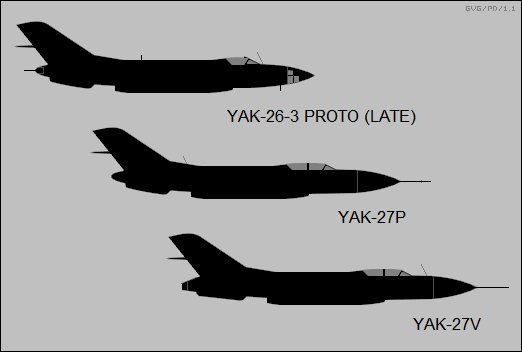
The Yak-26 and Yak-27 performed a flypast at Tushino in the summer of 1956, with NATO assigning them the reporting names "Flashlight-B" (an odd designation, given that the nose glazing suggested a bomber or reconnaissance aircraft, not an "F" for "Fighter" type) and "Flashlight-C" respectively. In fact, neither entered service -- yet again, they were left behind by improved concepts.
However, the prototype for the Yak-122 reconnaissance aircraft was upgraded to a new configuration as the "Yak-27R", with such features as revised nose glazing and improved wings, and it did enter service, with 180 production machines built. It performed a flypast at Tushino in 1961 and was given the NATO reporting name of "Mangrove".
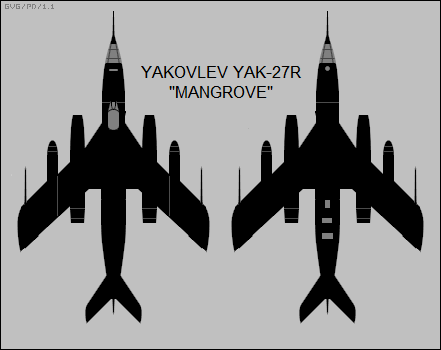
The Yak-27R featured RD-9F engines and a single NR-23 23-millimeter cannon, complementing its payload of film cameras. The wing featured leading edge root extensions, a dogtoothed outer wing, and a single fence on the outboard wing. The wingtips were extended but the outrigger landing gear wasn't, which placed it a short distance back from the wingtips. A blunt-nosed "slipper" type external tank could be fitted under each wing. The Mangrove retained the single-wheel nose gear and the shorter wheelbase of the Yak-25.
A few Yak-27Rs were used in trials, for example one being fitted with a combination wheel / ski landing gear for operations in snowy climates. The Yak-27R remained in VVS service into the 1970s, normally flying in natural metal colors. Its career was undistinguished, and it seems in hindsight like a modest accomplishment, given the bewildering amount of effort put into Yak-26 / Yak-27 development -- but all that work would lead to a next step with a bigger payoff.
BACK_TO_TOP* The RD-9F was by no means the last word in Soviet jet engine technology in the 1950s, and in fact even as it was going into operational service it was being outpaced by more powerful engines. The availability of one such improved engine, the Tumanskiy R-11-300 afterburning turbojet -- like that used on the MiG-21, and of the same family as the engine of the Yak-25RV Mangrove -- led to issue of a directive to the Yak OKB to build a tactical bomber along the lines of the Yak-26 using such new engines. The new machine was given the OKB designation of "Yak-129".
The modified "pointy nose" fuselage developed for the Yak-26 seemed like a good starting place for the Yak-129, with some modifications required, but the wing arrangement needed to be seriously re-thought. One problem was the fact that the R-11-300 engine was physically bigger than the RD-9F, leading to a clearance problem. The solution was to move the mid-mounted wing to a high-mounted position. The wing also had to be redesigned to permit higher speeds, with the new wing featuring a 45-degree sweepback at mid-chord, as well as a dogtooth and wingtip extensions as with the Yak-27R. The flaps were updated to a "Fowler" configuration, meaning they extended well behind the wing, making them more effective.
Three prototypes were built, the first two being rebuilds of Yak-26 machines. The initial prototype performed its first flight on 5 March 1958, with Volkov at the controls. The other two prototypes, which were assigned the service designation of "Yak-28", followed later in the year. Although OKB General Designer Alexander S. Yakovlev had not been very confident in the Yak-129, having been soured by the difficulties with the Yak-26 and Yak-27 development programs, performance was impressive and he became much more enthusiastic. Unfortunately, initial state trials resulted in a long list of complaints, though one of the big ones, the immaturity of the R-11-300 engines, was hardly the Yak OKB's fault.
The Yak-28 seemed promising enough to make fixing the bugs worthwhile, particularly since the VVS was desperate to obtain a supersonic tactical bomber, those being the days when subsonic performance was regarded as almost unacceptable. It was quickly approved for production, as the "Yak-28B", with the type performing a public fly-over at Tushino in 1961. It was assigned the NATO reporting name of "Brewer", which later became "Brewer-A" when other variants were observed.
* The Yak-28B was clearly a descendant of the Yak-25, but the evolution of the type meant there was very little in common between the two machines except for the general arrangement. The entirely new wings, engines, and engine nacelles have already been mentioned; the dogtooth wings were distinctive, as were the big engine nacelles, which had oval inlets with a prominent inlet bullet. Each of the Tumanskiy R-11AF-300 turbojets provided 56.4 kN (5,750 kgp / 12,676 lbf) afterburning thrust.
There was some commonality with the Yak-25 in the fuselage and tail, but there were many changes, such as the single-seat cockpit, with a back-sliding canopy, and the glass "pointy nose" for the bombardier. The Yak-28B also featured the twin-wheel nosegear and longer wheelbase, a brake parachute, and provisions for two rocket-assisted take-off (RATO) boosters. Airbrakes were deleted.
The twin NR-37 cannon were replaced by a single 23-millimeter cannon on the right side, with an ammunition store of 50 rounds. In initial production, the weapon was a Nudelman-Richter NR-23 cannon, but in later production it was replaced by a Gryazev-Shipunov GSh-23Ya cannon. The GSh-23Ya was an ingenious twin-barrel design, with the recoil of one barrel "charging" the other barrel in a "teeter-totter" fashion, providing a high rate of fire of 3,600 rounds per minute, compared to a maximum of 950 rounds per minute for the NR-23. It was originally a German design, but the Germans lost the war before they could put it into production, and the Soviets picked it up.
Normal bombload was 1,200 kilograms (2,645 pounds), though a 3,000-pound (6,600-pound) bomb could be carried in overload condition. All munitions were carried in an internal bomb bay, which was climate-conditioned to permit carriage of nuclear weapons. Typical weapons loads included a 1,200-kilogram tactical nuclear weapon; a single 3,000-kilogram (6,600-pound) or 1,500-kilogram (3,300-pound) general purpose (GP) high explosive bomb; two 500-kilogram (1,100-pound) GP, incendiary, or cluster bombs; four 250-kilogram (550-pound) HE or cluster bombs; or eight 120-kilogram (265-pound) GP bombs.
The Yak-28B could carry a 1,000-liter (264 US gallon) slipper tank on each wing. The aircraft was fitted with an RBP-3 bombing radar in a radome on the belly below the rear of the cockpit. The RBP-3 was linked to the aircraft's autopilot to permit automatic attacks. Of course, an optical bombsight was retained. Total production quantities of the Yak-28B are unclear.
* In parallel with the Yak-28B, a "Yak-28L" variant was produced that deleted the targeting radar, replacing it with a "DBS-2S Lotos (Lotus)" (hence the "L" suffix) datalink bombing system. The Lotos system involved two mobile ground stations that could direct the Yak-28L to perform precision attacks in any weather, day or night.
The Yak-28L also featured uprated R-11AF2-300 turbojets, with 60.8 kN (6,200 kgp / 13,670 lbf) afterburning thrust each, as well as a fully variable exhaust nozzle, instead of the two-position nozzle used on the R-11AF-300. The uprated engines required modifications to the engine nacelles, with large circular inlets replacing the oval inlets of the Yak-28B. Larger slipper tanks, with a capacity of 1,050 liters (277 US gallons) were also introduced. The Yak-28L was assigned the NATO reporting name of "Brewer-B". It was not particularly popular, with only about 111 built. The Lotos system, with its dependence on mobile ground stations, was too complicated, and it was also vulnerable to jamming.
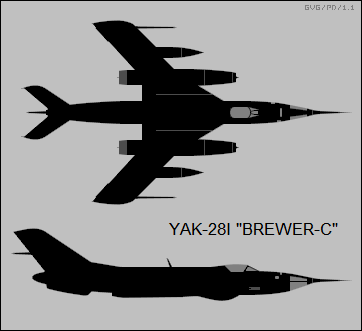
A third bomber variant, the "Yak-28I", featured an improved bombing radar, the "Initsiava-2 (Initiative-2)", hence the "I" suffix, with longer range and better resolution than the RPB-3 radar. The new radar was fitted into a slightly larger and reprofiled radome. The Yak-28I also featured the uprated R-11AF2-300 engines in the modified nacelles, and the other minor tweaks featured on the Yak-28L. The Yak-28I was assigned the NATO reporting name of "Brewer-C".
___________________________________________________________________
YAKOVLEV YAK-28I "BREWER-C":
___________________________________________________________________
wingspan:
11.6 meters (38 feet 2 inches)
wing area:
35.25 sq_meters (379.03 sq_feet)
length:
20.2 meters (66 feet 3 inches)
height:
4.3 meters (14 feet 1 inch)
loaded weight:
16,160 kilograms (35,625 pounds)
max speed (clean):
1,850 KPH (1,150 MPH / 1,000 NT)
service ceiling:
14,500 meters (47,570 feet)
range with tanks:
2,070 kilometers (1,285 MI / 1,120 NMI)
___________________________________________________________________
The Initsiava radar took a while to be persuaded to work properly, but the Brewer-C was built in good numbers, with about 223 produced. One was experimentally modified in 1969 with four underwing stores pylons to carry rocket pods or other munitions, being redesignated "Yak-28IM", with the "M" standing either for "Modifitzirovanniy (Modified)" or "Modernizirovanniy (Modernized)". The Yak-28IM was evaluated for a few years, but the scheme was not adopted for service, the Brewer bombers clearly having a limited future by that time.
BACK_TO_TOP* The three bomber variants weren't the whole story for the Brewer. Being a hot machine, there were worries that pilots converting to the Yak-28 might find it a handful, and so a two-seat conversion trainer, the "Yak-28U" -- where "U" stood for "Ubchebniy (training)" -- was produced.
The prototype was rolled out in 1962, with the type quickly going into service. It was basically a Yak-28B, with the R-11AF-300 engines and elliptical inlets -- since the Yak-28U wasn't meant for combat service, the lower-rated engines were judged satisfactory -- and a new nose that eliminated the bombardier's glazing and contained a second, independent cockpit for the flight instructor. The canopy of the nose cockpit hinged open to the right.
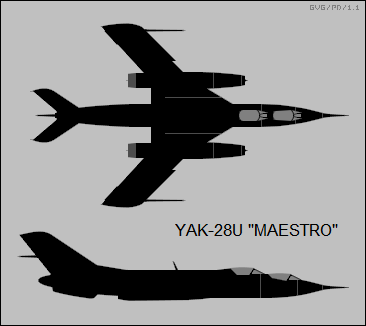
The cannon and radar were deleted. The bomb bay was retained, though it was fitted with a fuel tank. The Yak-28U was assigned the NATO reporting name of "Maestro", the "M" name indicating a "Miscellaneous" type. Total production was 183 aircraft.
* Of course a reconnaissance version, the "Yak-28R", was built, with the prototype rolled out in 1963 and the variant going into service in 1966. The Yak-28R was basically a Yak-28I, with the uprated R-11AF2-300 engines and an "Initsiava-2R" radar optimized for reconnaissance mission. Changes included:
There were sets of camera ports on the belly for the reconnaissance gear. The bomb bay was retained for carriage of photoflash flares, but the cannon was deleted.
A total of 183 Yak-28Rs was built, including subvariants. The type was assigned the NATO reporting name of "Brewer-D". There were a number of modifications and subvariants of the Yak-28R:
* In the mid-1960s, one Yak-28L was converted to a "defense suppression" -- or, as the Americans would say, "Wild Weasel" -- configuration, fitted for carriage of two Kh-28 (NATO AS-9 Kyle) anti-radar missiles in place of the wing tanks, with the bombing system replaced by a radar homing and warning system (RHAWS) to target radars. This machine was designated "Yak-28N", where "N" stood for "Nositel (Carrier)", meaning "missile carrier". The conclusion of the exercise was that a more modern machine was needed for the tough defense suppression mission, and the Mikoyan MiG-25BM "Foxbat-F" was obtained for that role instead.
In roughly the same timeframe, another Yak-28I was modified as a radar reconnaissance machine, carrying a "Bulat (Damask Steel)" side-looking airborne radar (SLAR) in the bomb bay, with the SLAR antenna deployed out of the bomb bay when observations were to be made. This machine was redesignated "Yak-28BI". It also was not adopted for service.
However, an electronic countermeasures variant, the "Yak-28PP", where "PP" stood for "Postanovschshik Pomekh (Countermeasures Aircraft)", did go into service. The Yak-28PP was developed in the late 1960s and entered production in 1970. It was something of a hybrid, with the cockpit and canopy of the Yak-28R, but the nose glazing of the Yak-28L; exactly why a countermeasures aircraft needed nose glazing is an interesting little question.
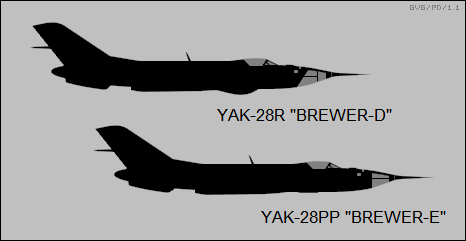
The Yak-28PP was fitted with the uprated R-11AF2-300 engines, and was crammed full of countermeasures gear, leading to a clutter of antenna fairings over the fuselage. The Yak-28PP was unarmed, but it could carry a pod of 57-millimeter rockets on each outer wing, with the rockets carrying warheads full of chaff to blind adversary radars; the aircraft was also fitted with chaff-flare dispensers for self-defense. The Yak-28PP was designed to accompany attack aircraft as they penetrated hostile airspace, using its jammers and chaff rockets to protect the strike package. Total production of the Yak-28PP is unclear.
* As mentioned, the Brewer series was rushed into service to give the VVS a supersonic strike capability. To no great surprise, at the outset reliability, particularly of the engines, was nothing to write home about. The Brewer was a more complicated machine than the previous generation of Soviet aircraft, with the result that manufacturing and maintenance were strained accordingly. The worst problems were fixed in time, but the type would never achieve the "shovel sturdiness" of the best Soviet gear, and the accident rate would be high -- though in maturity, the accidents were usually due to pilot error or failure to perform proper maintenance, the machine being unforgiving of either.
The Brewer was not a particularly friendly aircraft to fly; it was a high performance machine, and though the old Flashlight had good single-engine handling, the Brewer was less docile and used much more powerful engines, making it a nasty handful with an engine out. Few pilots could expect to handle the Brewer safely without familiarization in the Maestro trainer. Its supersonic range was short, and the bicycle landing gear configuration made loading it up with bombs laborious.
There were VVS pilots who really preferred the old, rugged, reliable Il-28 Beagle for the low-level attack role. However, the blazing performance of the Brewer was liked -- few pilots find flying a hot aircraft entirely disagreeable, as long as the thing isn't a deathtrap -- and VVS crews did learn some affection for the type, while acknowledging that it was a demanding mistress. It was nicknamed "Raschoska (Comb)", because with wing tanks it had a distinctly "toothy" appearance from below.
Brewers originally flew in natural metal colors, but later they featured disruptive camouflage schemes, which were applied in a few cases to the Maestro trainers even though they had no real operational capability. Brewer bombers participated in the invasion of Czechoslovakia in 1968, but dropped no bombs.
The only actual strikes performed by any of the Brewer bombers were on 9 November 1975 -- against Soviet shipping. The crew of a Red Navy frigate operating in the Baltic, the STOROZEVHOY, had mutinied the day before, and the authorities ordered the vessel sunk before it could reach neutral port in Sweden. Some officials were so vexed that they wanted the frigate obliterated with a tactical nuclear weapon, but they were overruled by calmer heads. Although the weather was lousy, a Yak-28B found the ship and dropped two 250-kilogram (550-pound) HE bombs behind its stern, persuading the crew to surrender.
The weather was so poor that another Yak-28B hit a Soviet bulk cargo carrier by mistake; another attacked the cutter belonging to the commander of the Soviet Baltic fleet, but missed. The attack on the cargo carrier fortunately didn't result in any fatalities, and the Red Navy compensated the shipping organization for the damage -- while also providing a few cans of pure grain alcohol to the crew as an apology.
The bomber Brewers were replaced by the Sukhoi Su-24 "Fencer" beginning in the mid-1970s, but the Yak-28R reconnaissance aircraft and the Yak-28PP countermeasures aircraft soldiered on. The Yak-28R was the only Brewer to see any real war service, flying reconnaissance missions in border clashes with the Red Chinese in 1969, and over Afghanistan in the 1980s. The Yak-28R was generally out of service by the end of the 1980s, but the Yak-28PP, which was an integral component of VVS strike doctrine, lingered on into the mid-1990s, after the fall of the USSR.
BACK_TO_TOP* The Brewer series evolved from an interceptor, the Yak-25, and evolved back into an interceptor again. In 1960, the Yak OKB was tasked with the development of a Yak-28 interceptor variant, designated the "Yak-28P". The type entered operational service with the PVO in 1964. The West didn't get a good look at the Yak-28P until 1967; it was then given the abstract NATO reporting name of "Firebar".
The Yak-28P was a fairly straightforward adaptation of the Brewer, with changes including a tandem two-seat cockpit under a single back-sliding canopy, featuring dual controls for familiarization, or to allow the weapon system operator in the back seat to spell the pilot; an Oryel-D (Eagle-D / NATO "Skip Spin") long-range fire control radar in a nose radome; and a Lazur (Prussian Blue) GCI datalink.
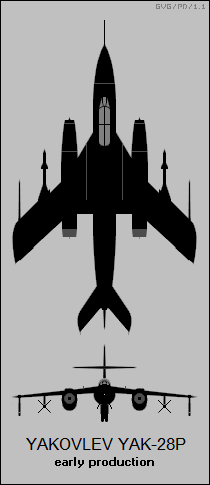
Armament was of course completely different, initially consisting of two R-8M-1 / AA-3 Anab AAMs, with one carried on each outer wing in place of the wing tank; additional fuel storage was placed in the fuselage, where the bomb bay had been on the Brewer. There was no cannon armament. Later on, a small pylon was added on each outer wing for an R-3S / K-13M1 (NATO AA-2 Advanced Atoll / Sidewinder clone) short-range heat-seeking AAM, upping the missile armament from two to four. Early trials had fitted a pylon for an R-3S AAM inboard of each engine, but this arrangement led to rocket exhaust ingestion problems with the engines.
Although prototypes featured the R-11AF-300 engine, production machines used the uprated R-11AF2-300 engine. Early production had a short radome; later production had a longer, more sharply pointed radome that improved aerodynamics and gave the machine a more dartlike appearance.
___________________________________________________________________
YAKOVLEV YAK-28P "FIREBAR":
___________________________________________________________________
wingspan:
11.6 meters (38 feet 2 inches)
wing area:
35.25 sq_meters (379.03 sq_feet)
length (late production machines with long radome):
20.6 meters (67 feet 9 inches)
height:
4.3 meters (14 feet 1 inch)
loaded weight:
16,400 kilograms (36,155 pounds)
max speed (clean):
1,840 KPH (1,145 MPH / 995 NT)
service ceiling:
16,000 meters (52,500 feet)
range:
2,150 kilometers (1,335 MI / 1,160 NMI)
___________________________________________________________________
435 Firebars were built in all up to 1967. The Yak-28P was an important asset of the PVO through the 1960s, normally flying in natural metal colors. It suffered from some of the reliability problems -- and the high accident rate -- that afflicted the Brewer, and it seems pilots were not always so happy with it: bomber pilots moving up from the Il-28 Beagle might have thought the Brewer a hot machine, but pilots of single-seat fighters going to the big Firebar saw it as something of a demotion. Throwing the Yak-28P around in aggressive maneuvers was strictly forbidden by PVO regulations.
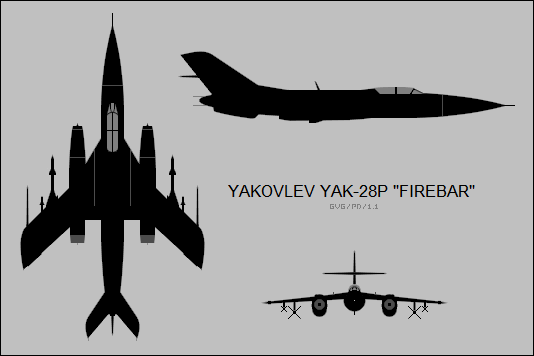
The Yak-28P never saw any combat action. One did get into an aggressive but bloodless dogfight over the Baltic with a US-built McDonnell F-4 Phantom, apparently a Luftwaffe machine, but after an extended session of jinking, climbing, diving, with a second Firebar joining the fray, everybody ran low on fuel and had to go home. It is unclear if this incident was due to mutual hostility or had an element of sport to it -- maybe it was both.
The only aircraft a Firebar was ever known to have shot down in anger, or at least helped to shoot down, was a Soviet machine, an Antonov An-2 utility biplane that a defector tried to fly over the Black Sea to Turkey on 13 March 1967. The An-2 didn't have much of a heat signature and was flying very low over the waves; the Firebar crew wasn't able to get a good missile lock, but the interceptor was able to use its long-range radar to guide a MiG-17 to the target, which then blasted the biplane into the sea with cannon fire. The Soviets took a brutally dim view of traitors, and doing in the defector wasn't an issue -- but the An-2 "Annushka" was generally regarded with affection, and it was something of a pity to destroy one.
* The phaseout of the Yak-28P began in the late 1960s, but stretched out through the next decade, with the last of them removed from PVO service in the early 1980s.
There were a number of experimental modifications of the Yak-28P, including a machine with "blown flaps"; various engine and AAM testbeds; and one with a liquid-fuel booster rocket in the tail, designated "Yak-28URP". There was also an attempt in 1964 to develop a successor to the Firebar, designated the "Yak-28-64".
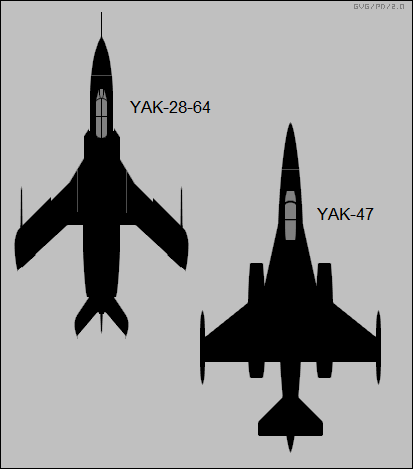
The Yak-28-64 was developed in competition with the Sukhoi Su-15 "Flagon" and incorporated some of the Su-15's design features. The R-11F2-300 engines were removed from the wing nacelles and placed in the fuselage, using rectangular intakes with splitter plates. The single ventral fin was replaced by twin ventral fins, and a drop tank could be carried under each engine. Flight tests began in 1966 but they didn't last long, since the Yak-28-64 was obviously a dog: performance was poor, and the type suffered from a number of unpleasant handling faults. The Su-15 was clearly superior and the Yak-28-64 effort was quickly abandoned.
The Yakovlev OKB never flew another fighter, not counting the notorious Yak-38 "Forger" vertical take-off (VTOL) fighter, said to be so unpleasant to fly that pilots would go on the sicklist rather than get into it; and the much better Yak-41 "Freestyle" VTOL fighter, which never went into production. The OKB did conduct a series of design studies, in particular for Soviet efforts in the early 1970s to develop a new "lightweight fighter" and a new "heavyweight fighter". The Yak offerings consisted of the lightweight "Yak-45" and the heavyweight "Yak-47", which were very similar configurationally, featuring twin engines and with something of a design flavor of the earlier Yak twinjet fighters. The requirements were actually met by the lightweight Mikoyan MiG-29 and the heavyweight Sukhoi Su-27.
BACK_TO_TOP* The following list provides a summary of the Yak-25 through Yak-28:
* Sources include:
* Revision history:
v1.0.0 / 01 nov 05 v1.0.1 / 01 nov 07 / Review & polish. v1.0.2 / 01 oct 09 / Review & polish. v1.0.3 / 01 sep 11 / Review & polish. v1.0.4 / 01 aug 13 / Review & polish. v1.0.5 / 01 jul 15 / Review & polish. v1.0.6 / 01 jun 17 / Review & polish. v1.0.7 / 01 may 19 / Review & polish. v1.0.8 / 01 mar 21 / Review & polish. v1.1.0 / 01 jan 23 / Format change.BACK_TO_TOP
